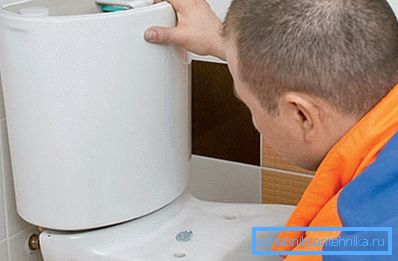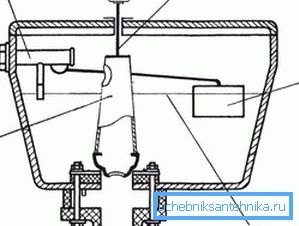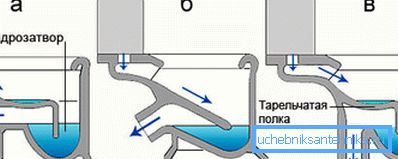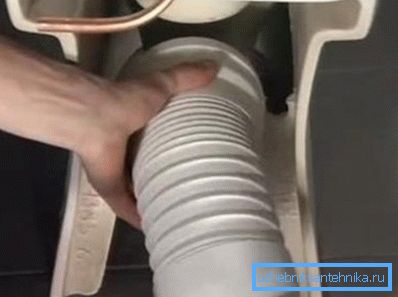Understand the situation flowing toilet
If you have a toilet after flushing or it happens all the time, then, first of all, you will have to establish a place where water seeps, and only after that take any action. The causes can be very different from each other, and if you do not find any cracks anywhere, it means that all is not lost and the device is subject to repair.
Below we will understand the causes and methods of troubleshooting, and the video in this article will help you.

Leak in the toilet
The reasons

- So, first of all, in order to understand how to fix the toilet that is flowing - with or without a button, you need to understand its device and we will start with the flush tank. In principle, they are all the same and the main differences consist only in the design of the drain itself, which at the bottom moment does not really bother us.
- If you have a tank intact (there are no cracks on it), then the leak can be in three places:
- Laying at the junction of the tank and toilet under the pear;
- In places of bolt fastening of a tank to a toilet bowl;
- At the float valve.
- In the first case, the leak occurs due to the old gasket (you could simply dislodge it with a strong pressure on the tank) or this gasket is made of porous rubber, such as foam rubber, and ceased to be airtight. Water can flow directly into the toilet due to a loose fit, and can also spread along the disc foot and fall onto the floor.
- In the second case, if you notice water on the floor, you can feel with your hand the bolted joints of the structure (bottom of the disc foot) - there are only two or four of them. If it is wet there, wipe them dry with a toilet paper, then wait until they get wet again.
- And the third, rather rare case, is when a leak is detected at the entrance, at the float valve of the toilet cistern, which can be located both on the side and on the bottom, and from either side.

- It is also one of the most likely places of an accident when water flows from under the toilet bowl, this is the connection point of the outlet pipe with a plastic corner or corrugated hose, and the discrepancy itself is most often possible due to the mismatch of the corners of the pipe and drain hole in the floor or wall.
- For example, sometimes you can see such a picture - in the Khrushchev, where the drain is located in the floor or in the niche (at the same level), the owners buy a new toilet with a direct outlet and the door does not open inside the bathroom, therefore, they are trying to press it as close as possible to wall and farther from the door. It is natural that a corner of 45? there it turns out to be big - the door interferes - and therefore a corrugated hose is installed, but they do it (again, quite naturally) under high voltage at the joints. As a result, the yoke of the corrugations simply slides off the nozzle at the top.
- In addition, on a corrugated hose or a plastic corner for various reasons, a crack may form, and the cause of the leakage may be there.
Note. When replacing a corrugated hose, do not spare money and buy a reinforced version. Its higher cost will override the price for further maintenance of the structure.
Elimination

So, let's see what to do - if the toilet bowl is draining at the dish-shaped stand, that is, either the water continues to constantly get inside, or it, through the plate, hits the floor. In this case, it is often enough to shut off the water, disconnect the tank from the plate and remove all the gaskets under the pear.
Then carefully clean the seat on the ceramics with a cloth or even with a brush, wipe the gaskets with a cloth so that there is no dirt on them. After that, put on the seat and under the tank silicone sealant for pipes, put the gasket and fasten the structure on the bolts.
Note. If the gasket is pressed, torn, or it cannot be cleaned, then in such cases it is better to replace the entire drain mechanism.

If a leak occurs from under one or two (four) fixing bolts (they are indicated by arrows in the top photo), then it is often quite enough just to tighten them, but this does not always bring results.
In new models, bolts are often made of plastic, so they do not rust and cannot simply be tightened - there is no danger to cracking ceramics, but a metal bolt in this case can be dangerous. But in any case, you can use silicone, sealed gaskets or change them together with the bolts.
In principle, the same methods of eliminating leakage will also be suitable for the interface of the water supply to the float valve. Here you need to check the integrity of the pads, clean them from dirt and, if necessary, use silicone to seal the connection.
Note. In any of the above cases, the instruction allows you to check immediately, until the silicone is completely dry. But after that you need to turn off the tap, drain the water and wait for the sealant to dry.

If the corrugated hose is installed in the tension and a leak is formed due to a mismatch, here you will have to either put a lot of silicone on this place and wait until it dries (the problem will be solved for a few years) or move the toilet down.
But, in order to move the toilet from the sewer riser, as a rule, it is quite enough to change the door in the toilet to hang it in the mode of external opening. To replace the plastic corner or corrugations you have to disconnect the toilet from the floor.
Conclusion
If you wish, you can carry out any of the operations described above with your own hands, without the involvement of specialists. But the key to success always lies in the correct definition of the problem. Good luck!